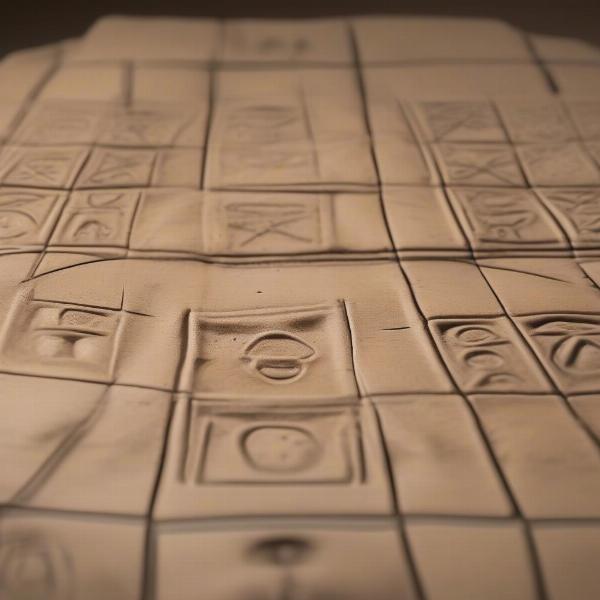The age-old game of tic tac toe, also known as noughts and crosses, has been a pastime for centuries. But who invented tic tac toe? Surprisingly, its origins are shrouded in mystery, making pinpointing the exact inventor a real challenge. Let’s dive into the fascinating history of this simple yet engaging game.
Unraveling the Ancient Roots of Tic Tac Toe
While the precise inventor remains unknown, evidence suggests tic tac toe’s ancestors existed in ancient civilizations. Games resembling tic tac toe have been discovered etched into Roman roof tiles and Egyptian pottery shards, suggesting its presence in various forms throughout history. These early versions, often called “three men’s morris,” offer clues to tic tac toe’s lineage. They involved aligning three markers in a row on a grid, showcasing a clear connection to the game we know and love today.
One of the earliest documented forms dates back to ancient Egypt, around 1300 BC. Archaeological digs have unearthed game boards scratched onto surfaces, suggesting a widespread enjoyment of similar strategic games. While not identical to modern tic tac toe, these ancient games highlight the enduring appeal of simple grid-based strategy.
 Ancient Egyptian Tic Tac Toe Game Board
Ancient Egyptian Tic Tac Toe Game Board
From Roman Roads to Renaissance Tables: Tic Tac Toe Through the Ages
The Roman Empire also saw variations of the game, known as “terni lapilli,” played with stones or other markers. These games spread throughout the empire, further solidifying the presence of tic-tac-toe-like pastimes in ancient societies. The simplicity of the game meant it could be easily adapted and played on various surfaces, from dirt paths to elaborate game boards.
Fast forward to the 13th century, and we find a game called “three men’s morris” gaining popularity in England. This game, played on a slightly different grid, involved moving pieces to create rows of three. While distinct from modern tic tac toe, its strategic alignment of markers further underscores the historical thread connecting these games.
 Medieval Three Men's Morris Game
Medieval Three Men's Morris Game
Tic Tac Toe in the Modern Era: Pen and Paper to Digital Screens
The 18th and 19th centuries saw the game solidify into the tic tac toe we recognize today. While the name “tic tac toe” emerged around 1884, its earlier name, “noughts and crosses,” appeared in print as early as 1864. This period witnessed the game’s transition from primarily a children’s pastime to a more widely enjoyed game, played by people of all ages.
The 20th century brought tic tac toe into the digital age. With the advent of computers and later, mobile devices, tic tac toe became a popular early computer game and a staple on mobile platforms. This digital adaptation ensured the game’s continued relevance and accessibility to new generations.
Why is Tic Tac Toe So Popular? A Timeless Appeal
What makes tic tac toe so enduringly popular? Its simplicity and accessibility are key factors. The game requires minimal setup and can be played virtually anywhere. Its strategic elements, despite the game’s simplicity, provide a satisfying mental challenge for players of all ages.
Furthermore, tic tac toe serves as an excellent introduction to strategic thinking, particularly for children. It teaches valuable lessons about planning, anticipating an opponent’s moves, and developing winning strategies.
 Modern Tic Tac Toe Digital Game
Modern Tic Tac Toe Digital Game
Beyond the Basics: Tic Tac Toe Variants and Strategies
While the standard 3×3 grid is the most common version, variations exist with larger grids and different winning conditions. These variations add layers of complexity to the game, challenging players to adapt their strategies. Exploring these variations can provide a fresh perspective on the classic game.
Developing winning strategies in tic tac toe involves understanding the importance of controlling the center square and corners. By strategically placing markers, players can create forks and block their opponent’s attempts to complete a row.
Frequently Asked Questions about Tic Tac Toe
1. What is another name for tic tac toe?
Tic tac toe is also commonly known as noughts and crosses.
2. When was the name “tic tac toe” first used?
The name “tic tac toe” appeared around 1884.
3. Is tic tac toe a solved game?
Yes, tic tac toe is considered a solved game. With perfect play from both sides, the game always ends in a draw.
4. What is the best strategy for tic tac toe?
The best strategy involves controlling the center square and corners, creating forks, and blocking the opponent’s moves.
5. Can you win tic tac toe if your opponent plays perfectly?
No, if both players play perfectly, tic tac toe always results in a draw.
6. What are some variations of tic tac toe?
Variations include larger grids, such as 4×4 or 5×5, with different winning conditions.
7. Why is tic tac toe popular with children?
Tic tac toe is popular with children due to its simplicity, accessibility, and the strategic thinking it encourages.
A Game for the Ages: The Continuing Legacy of Tic Tac Toe
While the exact origins of tic tac toe remain a mystery, its enduring popularity is undeniable. From ancient civilizations to the digital age, the game has entertained generations with its simple yet strategic gameplay. So, the next time you engage in a game of tic tac toe, remember its rich history and appreciate the timeless appeal of this classic game. Why not challenge a friend to a game and continue the legacy of this age-old pastime?

